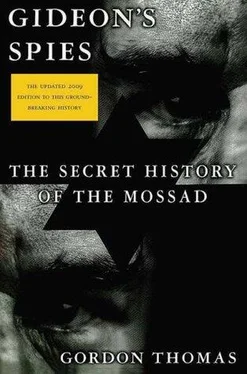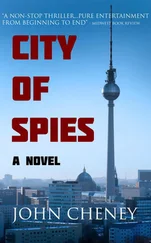Gordon Thomas - Gideon's Spies
Здесь есть возможность читать онлайн «Gordon Thomas - Gideon's Spies» весь текст электронной книги совершенно бесплатно (целиком полную версию без сокращений). В некоторых случаях можно слушать аудио, скачать через торрент в формате fb2 и присутствует краткое содержание. Город: New York, Год выпуска: 2009, ISBN: 2009, Издательство: Thomas Dunne Books, Жанр: История, на английском языке. Описание произведения, (предисловие) а так же отзывы посетителей доступны на портале библиотеки ЛибКат.
- Название:Gideon's Spies
- Автор:
- Издательство:Thomas Dunne Books
- Жанр:
- Год:2009
- Город:New York
- ISBN:978-0-312-53901-6
- Рейтинг книги:4 / 5. Голосов: 1
-
Избранное:Добавить в избранное
- Отзывы:
-
Ваша оценка:
- 80
- 1
- 2
- 3
- 4
- 5
Gideon's Spies: краткое содержание, описание и аннотация
Предлагаем к чтению аннотацию, описание, краткое содержание или предисловие (зависит от того, что написал сам автор книги «Gideon's Spies»). Если вы не нашли необходимую информацию о книге — напишите в комментариях, мы постараемся отыскать её.
Gideon’s Spies
Gideon's Spies — читать онлайн бесплатно полную книгу (весь текст) целиком
Ниже представлен текст книги, разбитый по страницам. Система сохранения места последней прочитанной страницы, позволяет с удобством читать онлайн бесплатно книгу «Gideon's Spies», без необходимости каждый раз заново искать на чём Вы остановились. Поставьте закладку, и сможете в любой момент перейти на страницу, на которой закончили чтение.
Интервал:
Закладка:
Bagram quickly became crowded with captured Taliban and foreign mercenaries. In the first weeks, two died during interrogation and several were left permanently physically incapacitated. But the center was soon overflowing with prisoners. At a meeting in London in April 2002 chaired by John Scarlett at the offices of the Joint Intelligence Committee and attended by CTIC officers and at which Meir Dagan was also an observer, it was decided that Bagram was not able to operate efficiently under such conditions. Even when detainees were transferred on the so-called Guantánamo Express to Cuba, the freight car cells at Bagram quickly filled up with new prisoners. Could another site—possibly several—be found? Scarlett had served in Moscow as an MI6 officer and recalled the existence of interrogation centers throughout the Soviet Union: he said the worst had been those run by the KGB in Uzbekistan, Moldova, and Poland. They could well serve CTIC’s purpose. Scarlett knew two senior officers of Polish military intelligence who had worked with GROM, a specialist Polish intelligence unit in Iraq. They were invited to London to meet senior members of MI6 who had worked in Eastern Europe. George Tenet, now in the dying months of his tenure, sent several senior officials to attend. The Poles confirmed the KGB interrogation centers remained intact and were used by local security services to question criminals.
Because of the considerable distance involved, the only way to transfer high-value al-Qaeda and Taliban terrorists from Bagram would be by air. CTIC already had its own aircraft, and its senior officer at the meeting said there would be no problem in arranging overflying and refueling rights in countries like Britain, Germany, and Spain. The Polish officers identified airfields within the old Warsaw Pact that could be used as stopovers; the air base at Tazar in south central Hungary, the Szczytno-Szymany air base in Poland, and the Markuleshti airfield in Moldova. During the Cold War they had all been used for secret operations by Warsaw Pact Special Forces. Interrogations had also been conducted there by the KGB.
The operational plans sufficiently advanced, it was time for them to be politically rubber-stamped. Scarlett informed Prime Minister Tony Blair, and Tenet briefed President Bush. Both quickly endorsed them. Recognizing that Poland would have an important role to play as the refueling point for all flights going to Uzbekistan—selected by CTIC to be the prime interrogation center for the terrorists—it was essential to get the support of Leszek Miller, the country’s soon to be ousted prime minister who had staunchly supported the war on Iraq. He immediately agreed to allow the Szczytno-Szymany base to be used as CTIC’s prime refueling point in Eastern Europe and would inform his cabinet colleagues of his decision. A London intelligence source told the author: “Miller may well have not known the ultimate fate of those who would be secretly flown in and out of his country. But he was also desperately wanting to remain a player in the post–Iraq war coalition.”
The first flight began in May 2002. A Gulfstream V executive jet, registration N379P, landed at Northolt airport, a secure military airfield near London. It had a long history of being a staging post for CIA and MI6 officers en route to secret missions in Europe during the Cold War. Under what the Ministry of Defense later called “standing regulations,” the only details listed of the Gulfstream flight were the names of the pilot and the aircraft owner. No record was made of any passengers on board. The aircraft was registered to Premier Executive Transport Services. Subsequently, the Mail on Sunday, a mass-circulation newspaper in Britain, reported that the company’s directors “appear to exist only on paper. Bryan P. Dyness, Steven E. Kent and Audrey M. Taylor, appear to have no personal details or previous employment history. This is the kind of sterile identity the CIA uses to conceal involvement in clandestine operations.”
On a sunny spring day the Gulfstream V and its unrecorded passengers flew across from Northolt to the Szczytno-Szymany base in northern Poland still blanketed by winter snow. After refueling, the aircraft flew south from there to Uzbekistan. Soon the executive jet was on a regular run, picking up detainees in Jakarta in Indonesia, Pakistan, and Bagram. One was the Yemeni microbiologist Jamil Qasim Saeed Mohammed, wanted by CTIC “in connection with the bombing of the USS Cole while the warship was at anchor off Aden.” He was flown to Uzbekistan and his fate remains unknown. Another passenger had been Muhammad Saad Iqbal Madni, an Egyptian suspect who had worked with the British “shoe bomber” Richard Reid. He was rendered from Jakarta to Egypt. His fate also remains unknown.
By December 2005, CTIC employed over one thousand people: field officers, analysts, translators, and liaison officers with foreign intelligence services. Their closest relationship remained with Mossad: its own katsas in Iran, Pakistan, Syria, and Afghanistan constantly provided updates of the movements of terrorist suspects on the CTIC list. The decision as to who would be rendered was made by CTIC in conjunction with CIA director Porter Goss.
The decision on how rendition would be carried out had been fine-tuned. CTIC officers were now stationed in twenty-two countries around the globe to handle the arrests and transportation of suspects. They were usually arrested by the local security service and held in solitary confinement until they could be flown out to a designated “black site”—the CTIC description of the interrogation centers. The decision as to which site a suspect should be sent was made by the senior CTIC officer on the spot.
“If a strong psychological interrogation with some physical force is required, a detainee is flown to Jordan. If a suspect is to be interrogated in between periods of strong physical force, he is sent to Egypt. For the most severe of torture for information, he is sent to Uzbekistan, where he is killed after he can reveal no more,” a senior Mossad officer told the author.
Craig Murray, then a British ambassador in Uzbekistan, wrote in a memo to Jack Straw, Britain’s foreign secretary, in November 2004 (a copy of which the author has seen): “The CIA chief in this country acknowledged to me that torture of those rendered includes the boiling in vats of prisoners.” Murray was relieved of his post, labeled as “mentally unstable,” and finally dismissed from the diplomatic service. By December 2005, he had become one of the first to publicly reveal details of the rendition process. As a result he said he was threatened by Britain’s security services.
But the flights continued with CTIC’s aircraft crisscrossing the world. The Gulfstream V had now been joined by a C-130 Hercules, a Casa Turboprop, a Gulfstream, and a Boeing 737. All were painted white and bore no markings. Some were also leased from the Premier Executive Transport Service. When contacted by the author, it declined to discuss the planes or the purpose for which they were used. A glimpse of what happened on board the aircraft came from two intelligence sources—one in London, the other in Washington.
“The prisoners are shackled to their seats and are gagged and often drugged during their flights. CTIC officers travel with them to their interrogation country. The flight manifests contain no details of who they are. At a refueling stop, the aircraft window blinds are drawn. No local official is allowed on board. Fuel is paid for by a credit card the pilot carries. It is billed to CTIC,” the London source told the author. The Washington source added: “In countries like Uzbekistan, Soviet-trained interrogators carry out the torturing. They have a list of ‘information targets’ to obtain. The answers are passed to the resident CTIC officer. He sends it to Washington.”
Читать дальшеИнтервал:
Закладка:
Похожие книги на «Gideon's Spies»
Представляем Вашему вниманию похожие книги на «Gideon's Spies» списком для выбора. Мы отобрали схожую по названию и смыслу литературу в надежде предоставить читателям больше вариантов отыскать новые, интересные, ещё непрочитанные произведения.
Обсуждение, отзывы о книге «Gideon's Spies» и просто собственные мнения читателей. Оставьте ваши комментарии, напишите, что Вы думаете о произведении, его смысле или главных героях. Укажите что конкретно понравилось, а что нет, и почему Вы так считаете.












